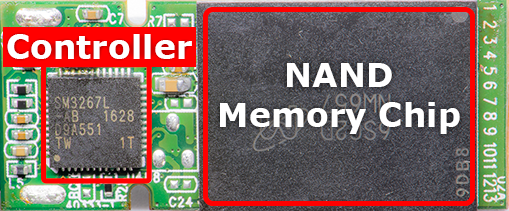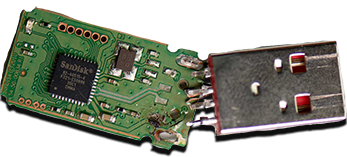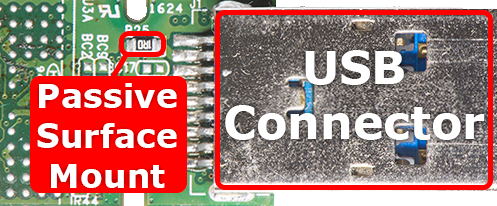How Flash Drives Fail
 Updated for 2018:
Updated for 2018:
Flash media is very robust but it can fail. Flash drives are like mini computers, they have a controller which has a CPU, RAM, EEPROM, and GPIO embedded in it. When the flash drive is inserted the controller loads its initial boot code from the EEPROM then loads the firmware from the NAND chip. If everything loads properly a copy of the FTL (Flash Translation Layer) mapping table (metadata) is copied into RAM. This metadata translates LBA sectors which the computer recognizes into blocks and pages which the NAND chip understands.
If the lookup tables become corrupt the flash drive can’t convert addresses in NAND memory to LBA addresses that the computer recognizes. Sudden power loss while writing data can corrupt the tables before they’re committed to flash memory or corrupt neighboring pages in flash memory. Typically the flash drive will lock itself into factory mode, shown as a gray drive letter, allowing the drive to be wiped and reinitialized using manufacture tools.
Every time data is written to flash memory it degrades the ability of that cell to read the original value back, think of it as a pencil eraser smudging paper. Low-end flash drives (eg: promotional drives) will often use refurbished memory with a high number of errors expecting the controller to handle error management itself. Controllers use error correcting code to fix up to a certain amount of errors when data is read back however refurbished memory chips will exponentially develop errors faster than the controller can fix.
 If a flash drive is bumped or dropped while attached to a computer it can break the connector off the flash drive. It can also cause damage to the circuit board tearing pads off or damaging one of the layers inside the circuit board. While it may appear to be an easy fix, using off the self-soldering gear or gluing the connector back in place will often cause more damage to the circuit board.
If a flash drive is bumped or dropped while attached to a computer it can break the connector off the flash drive. It can also cause damage to the circuit board tearing pads off or damaging one of the layers inside the circuit board. While it may appear to be an easy fix, using off the self-soldering gear or gluing the connector back in place will often cause more damage to the circuit board.
Some unbranded or counterfeit flash drives are hacked to display the wrong drive size using the manufactures mass production tool and then sold as larger capacity drives. For example, a flash drive with a 4GB NAND chip will report itself as an 8GB drive. These drives often work until the user starts to fill the drive with data after which it becomes unreadable. These fake flash drives are usually sourced from China and sold on eBay. If your data is NOT important you can download the mass production tool for the drive’s controller and reformat the drive using the correct capacity.
 Leaving a flash drive plugged constantly in may cause premature failure of the surface mounts which regulate voltage to the flash drive’s components. Often the resistance or capacitance values of a surface mount will fall out of spec and not produce the correct voltage. This often represents itself as a dead flash drive (no led, not acknowledged by the computer) or overheating. Power surges can destroy passive components or the controller. Flash drives often have fuses or power smoothing components that are susceptible to voltage surges or shorts. These components are often damaged by people trying to repair the media themselves for something like a broken connector.
Leaving a flash drive plugged constantly in may cause premature failure of the surface mounts which regulate voltage to the flash drive’s components. Often the resistance or capacitance values of a surface mount will fall out of spec and not produce the correct voltage. This often represents itself as a dead flash drive (no led, not acknowledged by the computer) or overheating. Power surges can destroy passive components or the controller. Flash drives often have fuses or power smoothing components that are susceptible to voltage surges or shorts. These components are often damaged by people trying to repair the media themselves for something like a broken connector.
Recover My Flash Drive has been a pioneer in flash media data recovery for over 11 years if you need your data recovered we can do it fast, securely and confidentially. We specialize in Flash Drives and have an industry best turn around time. Click here to send us a data recovery job.
